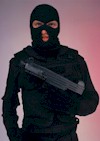
The symbiotic relationship between today's affluent suburban youth and urban gangbangers actually has parallels to something in which their parents may have participated: the Counterculture alliance of the late 60s between white students and social militants from the largely black underclass.
Psychologically, more was often involved in this earlier bonding than issues of social fairness and justice. With a few simple accoutrements of radical identity--longer hair, jeans, an army fatigue jacket (or better yet, a scuffed leather motorcycle jacket)--a heretofore pampered, sheltered, and utterly soft white kid from one of the better suburbs could pick up a rock, throw it in the general direction of a line of police, and proclaim himself a "street fighter."
Far from denying or downplaying this element of motivational chemistry, noted radical leaders tended to celebrate and promote it.
In Jerry Rubin's book, Do It!, two photographs are prominently displayed in close proximity to each other. In one of these, Jerry is a model junior citizen, all dressed up in his neat little suit and bow tie, with his hair slicked back just so, smiling ingratiatingly as he shakes hands with Adlai Stevenson. In the other, Jerry is scraggly and long-haired and war-painted, and as a consequence, more than a little unsetting to look at. The message is implicit but powerful: "See nice Jerry. See dull, tame Jerry. Now see wild Jerry. See Jerry grow balls."


